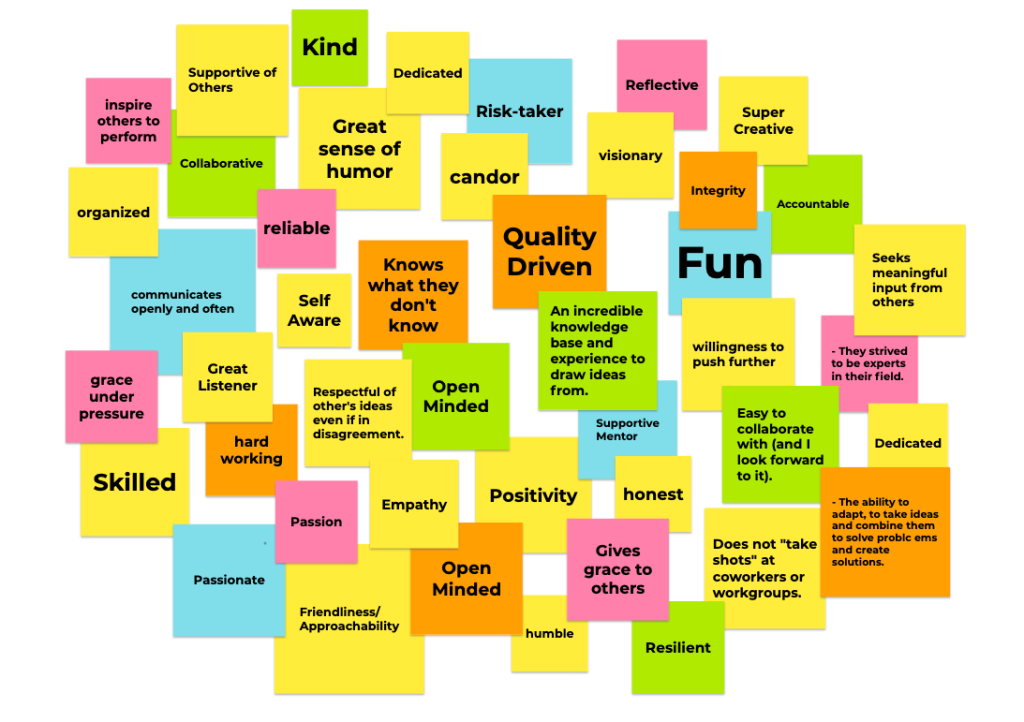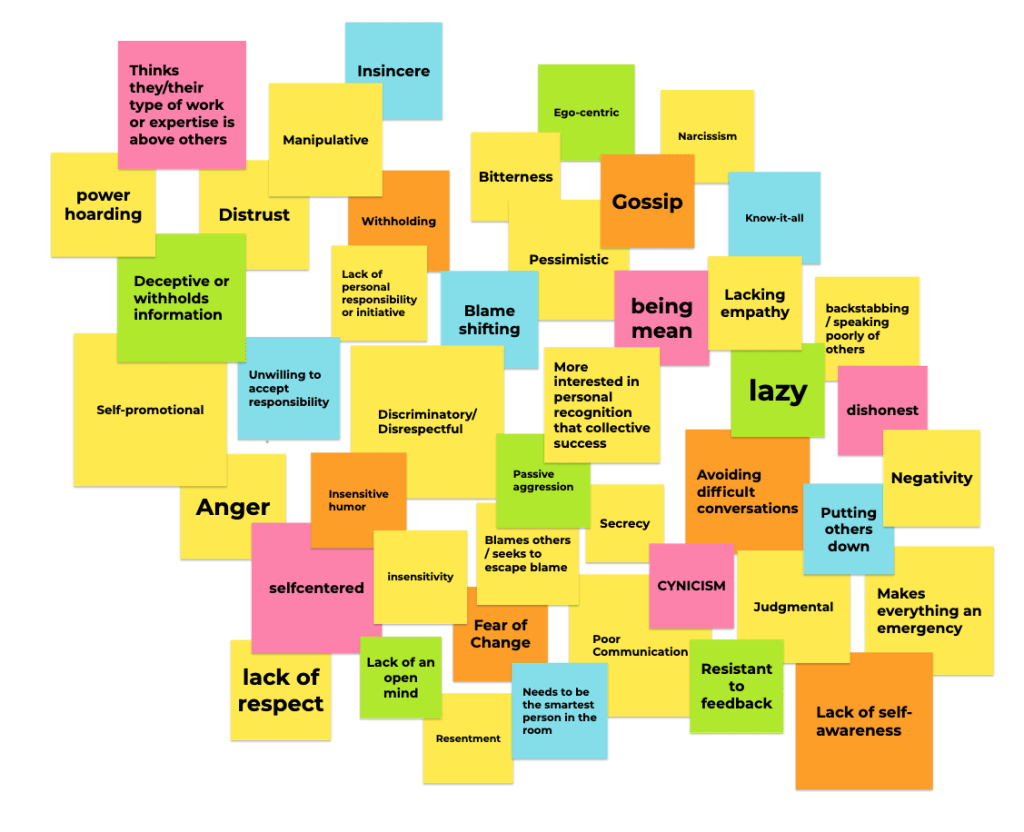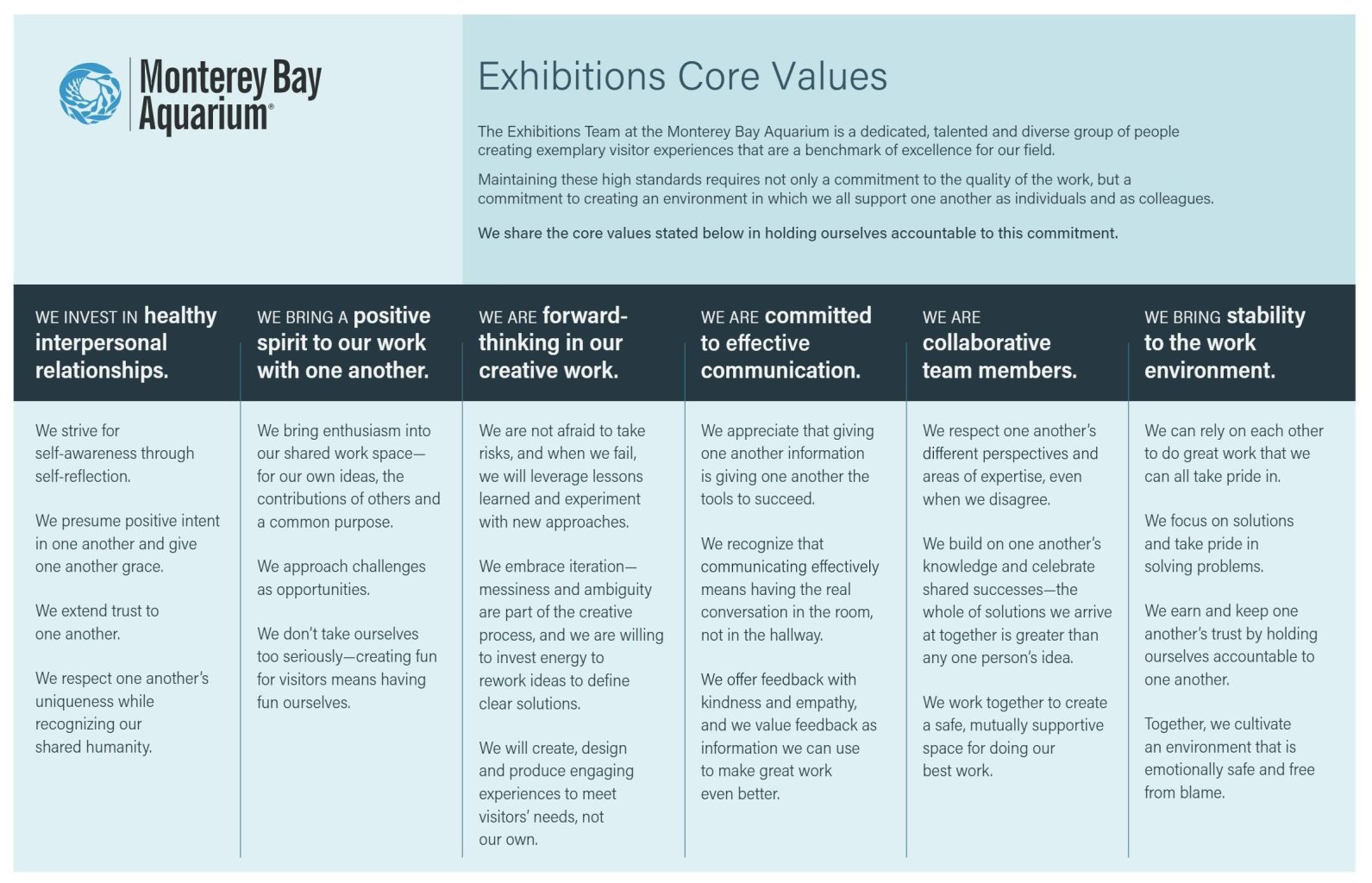
All aquariums, zoos, and museums have core values—beliefs, philosophies, and principles that drive the organization. These values support the organization’s vision, shape its culture, and ensure that all employees are working towards the same goals. At the Monterey Bay Aquarium (MBA), for instance, we have eleven formally defined core values: service, inclusion, respect, teamwork, leadership, integrity, quality, innovation, communication, sustainability, and fun. As an institution and as individuals, we use these core values to direct our day-to-day activities, influence our interactions with others, and guide our future plans.[1]
Following the departure of a long-tenured Vice President of Exhibitions, in May 2019, I became the second Vice President within a three-year period. Having experienced so much change, in addition to starting the most complex and technically challenging exhibition MBA had ever embarked upon, the Exhibitions team had not been able to establish a shared culture that fully embraced the organization’s core values.
During my first nine months, I met with everyone on my team individually and in groups. Staff shared what they thought did and did not work in our processes and culture. I attended meetings with staff in Exhibitions and from across the organization. I watched and I listened. What I saw and heard was a team that had gone through a great deal of disruption in prior years—comings and goings of staff, radical changes in job descriptions, inconsistent exhibition processes, leadership changes, emergence of dysfunctional and antisocial behaviors, emergence of fear, and for some, trauma. This resulting culture was not the fault of any one particular individual, but rather a perfect storm of factors that led to a team that did not embody trust, collaboration, or respect for their collective work.
After reflecting on the feedback, as a first step, I reorganized the division. This meant the departure of some staff and the addition of three new leadership positions to oversee content, design, and project management. I was ready to embark on the project of engaging all of the Exhibitions staff to work together to build a more cohesive and collaborative team. Then COVID happened. And like the rest of the world, MBA closed. Some of the Exhibitions staff was furloughed, then laid off. The rest of us shifted from working on-site to working from home, and staff anxiety increased due to an uncertain future. Many questions streamed through everyone’s mind: Would there be future layoffs? Who would be affected? Could we trust leadership in navigating us through a pandemic? How would we work remotely to develop and design the most complex exhibition MBA has ever created? [2]
The Exhibitions Division leadership team and I were all new to working with one another, and we needed to find common ground as a cohesive leadership team before we engaged our staff in the process of creating core values. We had conversations about the culture we, the leadership team, wanted within our division—the qualities we wanted to come forward (collaboration, communication, joy, positivity) and the type of environment we wanted to foster (creative, trusting, communicative, nimble). We also discussed the negative attributes we saw in various capacities that we wanted to get rid of (passive-aggressiveness, poor communication, ego). Based on these discussions, we developed a process that would hopefully be a safe space free of judgement and criticism, while empowering staff to step forward and help define our core values.
In August 2020, we began laying out our process for collaboratively defining a more cohesive team. We kicked off a multi-step process at a virtual all-division meeting which was attended by the entire Exhibitions staff.
Step 1: Ground rules
I defined the following ground rules for this process:
-
- This is your opportunity to have your voice heard, so be present and participate. Help shape our collective future.
- Be generous with each other during this process.
- Don’t name names.
Step 2: Define qualities we want in our working relationships
I asked each staff member to reflect on the following prompt: Think about a personal friend or professional colleague (past or present) that you admire and/or strive to emulate. What are the qualities that this person embodies that you think are important for the work environment? For example, “clear communicator,” “honest,” etc.
I then asked staff to take ten minutes to write down as many qualities as they could that resonated with them and answer the prompt. Then I asked them to select the top three and post them to our collaborative virtual whiteboard.

Step 3: Define qualities we don’t want in our working relationships
I then asked staff to think about the following prompt: What kinds of behaviors are harmful to relationships at work? I reminded them that these behaviors were not confined only to some people, but could be things that all of us exhibited at different times. Staff took ten minutes to write down their thoughts then selected and posted their top three.

Step 4: Grouping behaviors
As a group, we then read through the harmful behaviors and clustered similar answers together. As we went through, staff expressed agreement about what their peers had shared. One person said they didn’t realize that other staff felt the same way they did, to which many others nodded in agreement.
Next, the entire team went back and read through the positive qualities, and again clustered similar qualities together. From the team’s responses, several clusters of values developed: creativity, collaboration, emotional intelligence, and communication. An additional value that came out was professionalism and work ethic. This last value became a significant point of discussion and wordsmithing for the leadership team and me, as these words can foster perfectionism and a white supremacy culture,[3] neither of which we wanted to encourage.
Step 5: Defining our core values as a group
A few weeks later, the Exhibitions leadership team led several small group sessions for staff to reflect on what these words meant to them. After a second round of discussions, the leadership team and I further refined the distilled values. The entire Exhibitions staff was then given a chance to review and comment on the polished core values.

Our team holds MBA’s broader organizational values as our foundation, and the Exhibitions Core Values stand in the fore of our collective work. To keep them in the fore, we dedicate a part of each division meeting to core value shout-outs, where speakers describe how their colleagues exemplify specific core values. For example, in a recent meeting, I shared, “In support of the value ‘Effective Communication,’ I really appreciated when Erica asked me if the way she was organizing the exhibit messages and descriptions was an effective tool for me to review, as well as to share with others.” But we also use our core values as a means to move our work forward in a positive way when having an issue with a colleague. We bring each other in and reference what’s not sitting right based on our core values, for example, “We’re not giving each other the information we need to succeed, so we have some work to do in recommitting to effective communication strategies with each other.” Additionally, these core values have helped identify origins to problems without blame, in a case where, as one staff member put it, “critical feedback was never stated out loud because team members weren’t feeling mutually supported. So, we’ve identified some work to do on collaborative feedback sessions rather than blaming the person who didn’t speak up.”
As museums now work to reimagine themselves after COVID and increased calls to grapple with racial and social justice issues, now is the time for leadership to evaluate the cultural health of their departments and organizations as a whole. Collaboratively reassessing your values, or defining new ones, will produce more benefits than the time it takes to do this work. Your staff will feel invested and part of the greater whole. This foundational work will lead to better communication, productivity, and harmony amongst staff. In the Exhibitions Division at MBA, our staff has embraced the Exhibitions Core Values as part of the active and collaborative culture within the division. They shape how we interact with our colleagues within the division and across the organization, so that we create, support, and lift up our peers with positivity, empathy, and joy. They give everyone a chance to offer appreciation, feel appreciated, and provide working examples of bringing each other in with integrity, dignity, and passion.
[1] Monterey Bay Aquarium Core Values, August 23, 2018.
[2] To learn more about how our exhibition team shifted gears to effectively work online, please check out 5 Ways to Keep Your Exhibit Project Moving…Remotely and Excite, Build, Consider: A Structure for Open and Honest Feedback in Project Development
[3] “The Characteristics of White Supremacy Culture” from Characteristics of White Supremacy Culture by Tema Okun, updated Spring 2021.









Thanks much Beth for writing and sharing this article on building and supporting collaborative and healthy teams and for being part of the MuseumExpert.org panel yesterday!